Name
Name: Warszawa is the official Polish name, the [sz] is pronounced as [sh]. The name could derive from a tribe that settled in the area a long time ago. The German name of the capital is Warschau.
Location

| ||
| Warszawa |
Before the Second World War and the following shift of the borders to the west, Warsaw almost lay in the centre of Poland - today it's in the middle of Eastern Poland, to be exactly in the centre of the Województwo mazowieckie (Masovian Voivodeship). The largest part of Warsaw stretches along the left (west) bank of the river Wisła (Vistula), although many newer districts can be found on the east side as well. The area around Warsaw is just flat - the next smaller mountain is quite far away.
Warsaw lies en route between Berlin and Moscow - to Berlin it's around 600 km, to Moscow more then twice as far. This means that Warsaw is in a strategically important position and used as an important hub between east and west.
Population
Around 1.7 million inhabitants - this makes Warsaw the unchallenged #1 in Poland. Including the suburbs, the metropolitan area is home to around 3 million Poles.
Orientation
As mentioned above, the town mainly lies on the left side of the river Vitula. South of the centre, the Berlin-Moscow railroad runs from east to west, but large parts of the rails are underground. Parallel to the railroad runs the wide al. Jerozolomskie (Jerusalem Ave.). The underground main train station Warszawa Centralna at Jerusalem Ave. marks the heart of the new boomtown with numerous - and steadily increasing - skyscrapers. The Stare Miasto (Old Town) is far away from the train station - first it's an around 1,200 m long walk along Jerusalem Ave. eastwards and then, after turning left, around 2 km along the small road Nowy Świat (New World) all the way to the fairly small old town. The centre of the latter is marked by the Rynek Starego Miasta (Old Town Market Square). Of course there are busses running between the old town. But walking along Nowy Świat, which becomes Krakowskie Przedmieście (Krakow Suburb Str.) halfway, is worth a good walk at least for the first time - many interesting buildings line up along this street.
The historic centre of Warsaw is clearly defined and very compact. Everywhere in and around the old town, visitors will notice some remaining walls here and there with small commemorative plaques attached to it - reminders of the tragic history of the town during the Second World War. To put it in short - Warsaw is a fascinating blend of old and new. A view on the town from the window of a train is definitely misleading - there are many interesting spots in town.
History
Compared to other cities in Poland, Warsaw is comparetively young. There first time it was mentioned in historical documents was in 1281. In 1334, it was granted the right of a city. At the same time, →Poznań and Kraków played a far more important role. For the beginning, Warsaw became the capital of independent Duchy of Masovia. It only became a part of Poland in 1526. Thanks to its central location, Warsaw was then declared capital of the union between Poland →Lithuania in 1596. In the 18th century, between the three separations of Poland (see →History of Poland), the city was thriving as it never did before - but the rest of Poland at the same time went down.
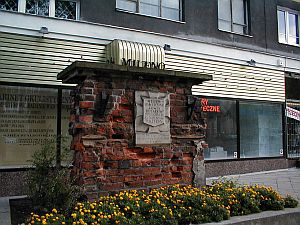
| ||
| Omnipresent: Reminders of the brutal World War II |
In the 19th century, Warsaw was relegated to one of many Russian provincial towns. Only in 1918, after the end of the First World War, Warsaw again became capital of Poland, which just gained independence again. The real tragedy started in 1939. When Hitler started the invasion in 1939, Warsaw experienced massive air raids. This gave the citizens an idea of what the next years would bring. Before the invasion, an estimated 1.3 million people lived in Warsaw. During the war, some 700,000 of them were killed the one or the other way. Half of them were Jewish. Before deportation, the Jewish were forced to live in two large ghettos established in the city. In 1943, Jewish organized the Warsaw Ghetto Uprising, which was put down by the occupants with greatest possible brutality. The ghetto was virtually leveled to the ground and almost all Jewish murdered. In 1944, Poles started the so-called Warsaw Uprising. The Red Army was already in striking distance - the noise of the front could be heard in Warsaw - but the Soviets did nothing to support the uprising. Instead, they waited until the end of the uprising. The German revenge was devastating - hundreds of thousands of citizens lost their life during and after the uprising. The old town was systematically dynamited. After the end of the war, Warsaw was nothing more then a giant pile of rubble.
With large efforts, wide parts of the old town were rebuilt between 1946 and 1953. Among other things, two paintings of famous Canaletto - the same, who dedicated many beautiful paintings to Dresden - were used to restore the panorama of Warsaw. It was well worth the effort - the entire old town was later declared UNESCO World Cultural Heritage. Besides that, the post war decades formed the appearance of the town in many different ways - from Stalinistic super large buildings to dull residential areas in the 60ies, 70ies and 80ies and hypermodern bank and company buildings which are mushrooming everywhere since the 1990ies.
Getting there / transportation
The international airport Okęcie lies south of the town and isn't far away. Shuttle bus #175 frequently runs between the main train station and the airport.
Warsaw has three large train stations - these are, from west to east, Warszawa Głowna (main train station), Warszawa Centralna (Central Station) and Warszawa Wschodnia (East Station), with the latter already on the eastern side of the river Vitula. As mentioned above, Centralna is the most convenient, but even this station is far away from the old town. Most of the international trains passing Warsaw stop at all of the three stations. There are direct trains to →Minsk, →Brest, Moscow, →Ky'iv (Kiev), Berlin, Brussels, →Prague, →Budapest as well as to almost all larger cities in Poland. For more detailled information see →Poland travel information.
Public transportation in Warsaw includes bus, tramwaj (tram) and metro (subway). However, the latter consists of few lines only.Tickets are all the same and cost 2.40 Zł per ride.
Warsaw as it is today has many faces, but the most beautiful of course is that of Stare Miasto (Old Town). Once there, it's not sure what to admire more - the beauteousness of the old town or the fact, that all of this has been rebuilt by the Poles immediately after the war, a time that brought a lot of hardship and suffering for everyone. The Old Town itself is rather compact - some 500 metres long and about the same width. The semicircular area is limited by the broad river bank street Wybrzeże Gdanskie (Gdansk River Bank) in the east and the rest by a circular fortress wall, a moat and parallel to that a street named Podwale (Wall Moat). The most impressive part of the former fortification system is called Barbakan (Watchtower), a massive structure dating back to the 15th and 16th century and marking the north entrance to the old town.
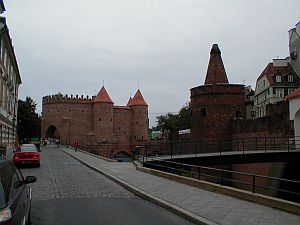
| ||
| Barbakan, part of the fortification system |
North of the Barbakan starts the also rather small and, despite the name, quite old Nowe Miasto (New Town). There's plenty to see in the old town. Starting from the south, visitors first enter Plac Zamkovy (Castle Square). Apart from several posh restaurants and souvenir booths there's also the tourist information. Right in the middle of the square stands Kolumna Zygmunta III. (Sigismund III. Column) - a monument dedicated to the person who had Warsaw the capital of Poland.
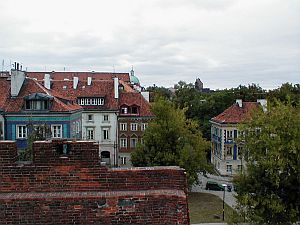
| ||
| View from the fortress to the new town |
As everyone would expect, the Castle Square hasn't got its name for nothing. The attached castle is simply known as Zamek Królewski (Royal Castle). And it can be considered a real jewel. A small exhibition inside the castle shows what the castle looked like in 1945 (actually more what it didn't look like - it was just a pile of bricks). The reconstruction, finished in 1988, was definitely a success. From outside, compared with other castles, it doesn't look very spectacular, but it's the splendid interior.
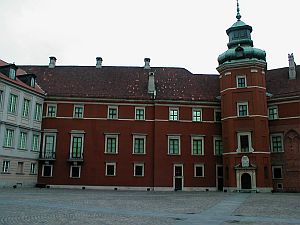
| ||
| Courtyard of the old castle |
Fortunately, most parts of the interior could be evacuated before the destruction of Warsaw. Above mentioned Sigismund III chose the castle as his residence. At that time, the baroque Warsaw castle was considered to be one of the finest castles in Europe. Later, it was used in many different ways - as a parliament building, cadet school and so on.
The rich interior is now used by the castle museum and several exhibitions - all of them with their own entrance tickets. If you want to see the essential parts only, the ticket costs 9 Zł. Entrance is free on Sundays, but some parts are closed to the public then. But it's still enough to be deeply impressed.
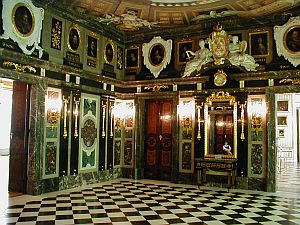
| ||
| Faszination guaranteed - the marvellous castle |
Central Rynek Starego Miasta (Old Town Square) is only 200 metres away from Castle Square to the north. Halfway is the Archikatedralna św. Jana (St John Cathedral) - a beautiful gothic building from the 14th century. The market square itself is surrounded by beautiful buildings mainly built during Warsaw's heyday in the 17th and 18th century. Technically of course, the recent buildings are rather replicas, rebuilt after 1945. The Muzeum Historyczne Miasta Stołecznego Warszawy (Museum of Historical Places of the Capital Warsaw) at the square illustrates what the square looked like in 1945 - nothing was left. The reconstruction of the square was, same as the castle's, a full success and worth the effort.
There is plenty to see along Krakowskie Przedmieście (Krakow Suburb St.) which starts at Castle Square and runs southwards. Along this street, numerous churches, museums, a university and some palaces line up. As for the latter, one shouldn't miss Pałac Radziwiłłów (Radziwill Palace). The Radziwills were an old, very influential noble family with their residence in Warsaw - however, they later moved their main seat to →Nyazvizh (Belarus), which was then a part pf Poland. Nowadays, their old palace is used as the Prime Minister's residence.
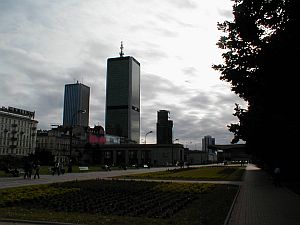
| ||
| The new Warsaw |
Krakow Suburb Str. is a part of the around 4 km long Szlak Królewski (Royal Route), connecting the Royal Castle with Łazienkowski-Park and an attached castle in the south of the city. There, visitors can also see a botanical garden and the Chopin Museum.
Within sight of Radziwill Palace to the west stands the National Theatre. South of the theatre there's pl. Józefa Piłsudskiego (Pilsudski Square) - Pilsudski was a very successful field marshal during several military campaigns - and Poland's dictator between the First and the Second World War (see also →History of Poland). To say it in a rather soft manner - Pilsudski was no angel, and naming one of Warsaw's central squares after him was no decision without long discussions. Attached to the square, to the west, starts a large park. Behind that park runs one of the main streets of the city - Marszałkowska (Marshal St.). Follow this broad street to the south and you will approach the new, booming Warsaw with for Europe unusually large skyscrapers made of glass and steel and lots of construction sites - clearly depicting that the town is thriving.
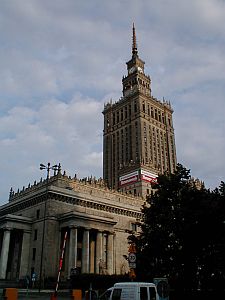
| ||
| A white elephant: The palace of culture & science |
Warsaw's largest building however - located right in the centre of the modern part - is a little bit older. It's called Pałac Kultury i Nauki (Palace of Cultural and Science). This huge building was a present from Stalin to sorely afflicted Warsaw. And it was a real "white elephant", since Varsovians were never really happy with that giant something. With 234 metres it's the tallest building in the entire country, though this might have already changed by the time you read this. Almost exactly the same buildings can be found in Moscow, a smaller version in →Riga and some other Eastern European capitals. The structure contains several conference halls, a Museum for Technology, cinemas and many more. There's also an observation platform on the 30th floor.
Unfortunately someone got the idea to use parts of the buildings as a giant billboard. Hence, really large and ugly billboards cover parts of the building - which doesn't really make it look more attractive. The small park in front of the palace as sometimes used for flea markets and events. The modern structure opposite the palace is the entrance building of Warsaw's underground Central Station.
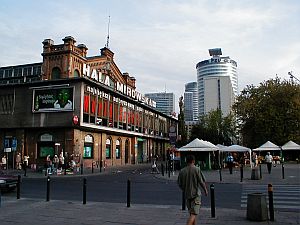
| ||
| The Mirow Market Halls |
Talking about flea markets. There are many of them. Not just flea markets, but old style market halls and bazaars. Many of them were shut down when people started to buy their things in super markets and shopping malls somewhere out of town. However, some of them survived and are potentially interesting. From Central Station for example, walk around 1.5 km northwards along al. Jana Pawła II. (Pope John Paul II Ave) and you will see Hala Mirowska (Mirow Halls) on the right - a beautiful market hall which is still in use, always vibrant and worth a short visit.
These are by far not all sights of the town. As mentioned above, Warsaw has countless memorial sites commemorating the heroes and victims of the Warsaw Uprisings, a synagogue (though there were many more before the war), some museums and many more interesting buildings. Nevertheless - if someone asks me what I would recommend to see when for one or two days only in Poland - I wouldn't include the Polish capital. There are more fascinating places in the country. But when spending a week or more in the country, a visit of multifaceted Warsaw should be part of the itinerary
Needless to say that there are many accommodation options in Warsaw. But for many years, an interesting hostel á la Villa Helga in →Bukarest or Old Town Hostel in →Vilnius was missing. Things have changed - there's at least one international hostel catering to backpackers mainly now - with the, well, somewhat weird name Dizzy Daisy . I hadn't had the chance to stay there so I can't judge the place. It's easy to find it on the internet (thanks to that unique name).
There's an accommodation booking agency inside the Central Station, but it's not always open. Once we ended up staying in the Pokoje Gościnne Feredacji Metalowcy (Guest House of the Metallurgist Society). Considering the location and the rooms, it's not a bad choice. A double room costs some € 20 - with shared bathroom. However, the location makes it a good deal really: It's 500 metres only to the old town. Address: ul. Długa 29, Tel.: 022-832 4021, Fax: 022-635 5460.
- www.e-warsaw.pl: Official website of Warsaw - multilingual, of course with English as well. Parts seem to be machine-translated but it's still worth a look.
- www.warsawtour.pl: Website of the Warsaw Tourism board. The English version features regular updates on interesting events and a lot of useful information.
Do you have or do you know a good website about Warsaw? Don't hesitate, let me know! After checking it, I would love to add it to the link list. You can submit a link by using the →contact form. Note that commercial websites will be treated differently.
©2024 Europe-East.com

 Albania
Albania Poland
Poland